With spring on the way, our thoughts are turning to lovely days in the garden and the chance to entertain outside again. Which also means thinking about what to do with our gardens. Melbourne has a very specific climate, which means there are some plants that will thrive better than others. If you are wanting to bring some fresh life to your garden, or you want to do a complete overhaul this spring, we have the guide below. Today we are going to discuss what to plant in spring, in Melbourne.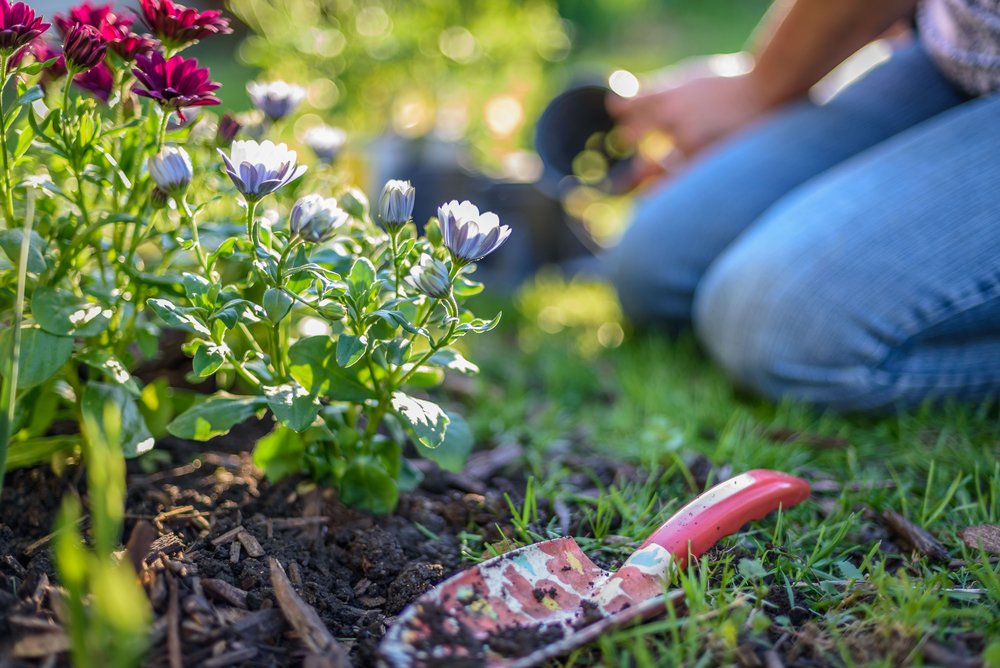
How to Prepare Your Garden for Spring
To start off, it is important that you prepare your garden, whether you are just adding new plants or complete overhauling the look of your landscape. Pruning, clearing out weeds, and removing debris is an important part of not only making your garden safer after winter but also more presentable. Winter is a volatile time in Melbourne, with wild winds and storms that can bring down branches, trees, and a whole mess of things. So it is important to clear all this out before turning to your garden beds themselves.
Once you have cleared out all the mess, it is time to replenish your soil and garden beds with a good helping of compost and/or mulch.
Composting
Composting is a fantastic addition to your soil during spring. Compost rejuvenates established gardens and improves the soil structure in new gardens. It also helps conserve soil moisture and can even be used as a mulch (especially for roses) which means you can save money if you don’t want to mulch your garden as well!
Mulch
We have discussed mulch in another article. You can find it here. However, let’s discuss it briefly here. Mulching is essential in Melbourne’s climate as it helps insulate your plants’ roots from the autumn and winter frost to which we are prone. Like compost, it also helps retain soil moisture during warm seasons while adding nutrients and improving soil health. Finally, it also reduces soil erosion, meaning you won’t need to rebuild your garden beds as often.
Before mulching, you can also sprinkle in a light, slow release outdoor garden fertiliser to ensure your plants get all the appropriate nutrients they need.
What to Plant in Spring: Melbourne
Below, we are going to discuss the best plants to add to your garden during spring. This will include flowering plants, fruiting plants, vegetables, and herbs. Explore our list below!
What to Plant in Spring: Flowering Plants
Spring flowers are some of the most beautiful to have in your garden. Not only is this a great time to plant flowering plants for spring, but also for the months to come, so your garden is always in bloom.
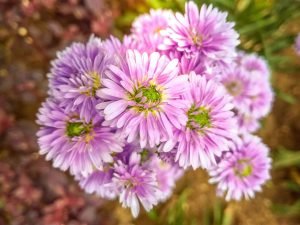
Asters
Asters add colour to any garden with little work. They bloom in later summer and early autumn, while alpine versions bloom in spring. By using a variety of Aster species, you can has beautiful blooms all year. They can reach up to a metre in height, while the alpine species grows compact and mounding, stake and prune back taller species to create the same, more compact look to the plant. You can grow from seed or as a potted plant in spring.
Plant in full sun to part sun in loamy, well-draining soil. Ensure newly planted asters are kept moist and continue watering until it stops blooming. Water at the base and don’t splash the foliage as that can encourage mildew.
Asters need little in the way of maintenance. Simply remove the dead blooms to keep the plant flowering. If powdery mildew does occur, use an insecticide spray.
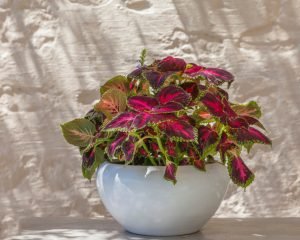
Begonias
Begonias make beautiful outdoor and indoor plants. They bloom in summer until frosts begin, though bloom types can vary if grown indoors, and some varieties bloom all year. Begonias range from 6-12 inch houseplants to bushy outdoor plants that can reach 5 feet tall. They are best planted in full sun to shade, depending on the specific variety of begonia you are planting.
Begonias are frost sensitive, so plant them in spring as soon as all the frosts have passed. They prefer partial shade to filtered sunlight, with morning sun and afternoon shade being the best, especially when we reach our hotter summer months. Plant in areas where the begonia will get good air circulation. They like an evenly moist, well-draining soil with added organic matter. It is a good idea to apply a balances, water-soluble fertiliser once a month during the growing season.
Watering is important for healthy begonias. You should keep the soil moist at all time, but not wet as this can cause root rot. Water at the base of the plant to prevent fungal diseases.
**Be aware that begonias are toxic to pets, with the tubers being the most toxic part. If you have pets, this might not be the best plant for your garden.
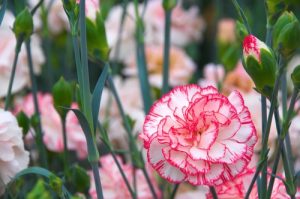
Carnations
Carnations are a beautiful, evergreen, clump forming flowering plant. They flower primarily in spring through to summer. The flowers are loosely tufted and come in a range of colours including red, mauve, yellow, pink, or white. Carnations are also perfumed, bring a soft, clove-like scent to your gardens. They prefer a full sun position in your garden in a well draining soil. In warmer climates, it is important to protect them from the hot afternoon sun.
Carnations are extremely easy to grow and are ideal for cottage style gardens, edging, flower beds, and growing in pots. They are also a traditional favourite as cut flowers. Carnations feature a long stem and will attract butterflies to your garden. They can be planted any time of the year, but spring is best. Keep them well watered during their main growing periods as the plant likes moist soil but be careful not to overwater. Carnations like a good, general purpose fertiliser I early spring.
Make sure you remove dead flowers to encourage the plant to keep flowering. Cut the plant back to half in autumn when flowering has finished. And watch out for pests like snails, slugs, and aphids.
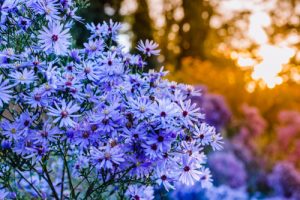
Daisies (Blue Daisy/Agathea)
Blue daisies, also known as agathea, blue marguerite, or blue kingfisher, are a bushy, spreading evergreen perennial. They are fast growing with bright blue and roundish green shaped leaves. They love a full sun position though they do like protect from the hot afternoon sun. Blue daisies bloom from spring to autumn. If the summer heat is extremely hot, the blooms will retreat until the weather is cooler. They are very quick to establish and are a very low maintenance plant. They are fast growing, hardy, long flowering, long lived, and wind and drought resistant. Blue daisies are ideal ground cover for cottage style gardens, pots, garden borders, mixed garden beds, and rockeries. They also attract bees and butterflies.
Blue daisies are best planted in spring from seed or a potted plant. They prefer a well-drained soil enriched with plenty of organic matter. Dig through well, broken-down compost before planting. Planting in full sun to part shade, with about 1m between plants. Keep your daisies well-watered in summer and mulch well to help retain moisture. Fertilise well with a slow release fertiliser when planting or when new growth starts forming. Prune back lightly in late autumn after main flowering it maintain the compact shape.
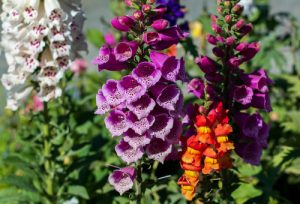
Foxgloves
Foxgloves, like lavender, have long been a beloved part of cottage gardens. They are perfect for creating vertical interest and a stunning swathe of colour. Foxgloves come in a wide range of colours including white, lavender, pink, red, yellow, and purple. They thrive in partial to full shade, depending on the summer heat – the hotter the summers in your area, the more shade your foxgloves will need.
They grow best in rich, well-draining soil. You can encourage the regrowth of your foxglove flowers by not allowing the soil to dry out or get too soggy. You can grow for seed, but they will only produce blossoms in their second year. And if you don’t remove the dead flower heads, foxgloves will reseed themselves abundantly. By using your foxgloves as cut flowers to decorate your indoor space, you can decrease the reseeding issues. If the plants have dropped seeds, thing the seedlings out during spring, ensuring the plants are at least 45cm apart. They are best planted in spring, with the spent flowers pruned back as soon as they stop flowering to prevent reseeding.
Excitingly, hummingbirds are often attracted by foxglove nectar, so keep an eye out for these rare and beautiful birds!
**All parts of the foxglove are poisonous to children, pets, and especially horses. If you have small children or keep animals, it is best to avoid using this plant in your garden.
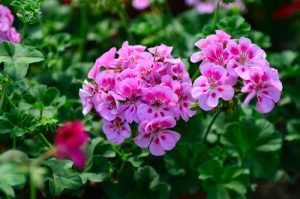
Geraniums
Geraniums are not only popular as a bedding plant in gardens, they are also a gorgeous plant to grow indoors or in hanging baskets to brighten up balconies. They are easy to grow as long as you pay attention to their needs, as these will differ for indoor and outdoor plants. If you are growing your geraniums indoors, they prefer full light but will tolerate moderate light conditions. Geraniums also need an indoor temperature around 18-21°C during the day and at least 13°C at night. They need a well draining soil.
If you are growing geraniums outdoors, they require moist, well-draining soil similar to that of indoor potting mix. They prefer a soil that is an equal mix of soil, peat, and perlite. Plant your geraniums where they will get at least 6-8 hours of sunlight each day. Plant in spring, once the threat of frosts is well passed, as they are not frost resistant. Ensure they are spaced at least 20cm apart and mulch well to help retain soil moisture.
Care for both indoor and outdoor geraniums is very easy. Water deeply once the soil begins to feel dry for indoor plants, and at least weekly for outdoor plants. Fertilise using a water-soluble fertiliser with additional organic matter/compost added to the soil every 4-6 weeks.
Indoor and/or potted plants may need to be repotted once they become overgrown, which is usually when the plant begins wilting between watering. Regularly remove dead flowers on both indoor and outdoor plants to encourage the plant to keep flowering.
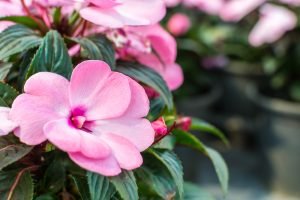
Impatiens
Impatiens have always been loved as a bright and cheerful annual, perfect to lighten up any dark and shady parts of your garden. They are easy to grow, whether from well-rooted purchased pot plants, seeds, or cuttings. If planting from pot plants, make sure you keep them well watered. Impatiens are sensitive to a lack of water and will wilt quickly if they lack water. They are ideal as border plants, bedding plants, or as containers for verandas, patios, and balconies.
Impatiens prefer moist but well-draining soil, and partial to deep shade. They don’t like full sun in general but if you do want to plant them in full sun, you will need to acclimatise them to the harsher climate. This can be done by exposing the plants to increasing amounts of sunlight over the course of a week. Plant once the danger of frost is well past and water plants thoroughly after planting. You can plant impatiens quite close together, leaving at least 5cm between each plant. The closer the plants are, the faster they will grow together to form a bank.
Once planted, impatiens will need at least 5cm of water a week. In temperatures over 29°C they will need at least 10cm of water a week. When planted in containers, they will need to be watered daily, and twice a day when temperatures reach over 29°C.
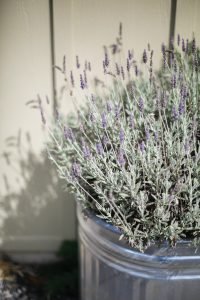
Lavender
Lavender is a popular, hardy perennial that has a strong, distinctive fragrance and beautiful purple flowers. Originating from the Mediterranean , lavender loves the sun and proves itself to be drought hardy once it has become established. Lavender is also perfect for attracting bees and other pollinators, making it ideal for the health of your garden. This is a highly versatile plant that is a favourite in cottage style gardens, in garden beds, as borders, and even as hedges. For those living with smaller gardens and apartment balconies, lavender grows well in pots and containers.
When planting lavender, choose a position with full sun and minimal moisture. Lavender can survive in a range of soil from poor to moderately fertile. They hate moisture, however, so add an organic matter to improve drainage. It is best planted in spring and autumn, spaced at least 30cm apart. Be careful not to overwater as lavender prefers dry conditions. Once your lavender has established, add a slow release fertiliser and top dress the soil with a complete fertiliser in late autumn. Add a straw mulch in winter to protect from frost. Prune back your lavender after each bloom of flowers, to keep the plant manageable and tidy. But be careful not to cut back to the old wood as this can cause damage and affect the next season’s flowering.
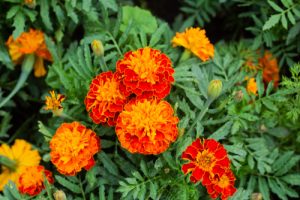
Marigolds
Marigolds are bright blooms that are easy to care for and popular as Mother’s Day gifts. They are also popular as part of growing projects in schools. You can easily grow marigolds from seeds or buy them as established plants from your local nursery, like Aumanns. If you want to grow from seed, you will need to plant your marigolds indoors bout 50-60 days before the last frost of winter.
Marigolds are a highly versatile flower. They enjoy full sun, hot days, and grow well in dry or moist soil. Their hardiness is one of the reasons they are so often found as bedding plants and container plants. They are perfect to brighten up any space, from large gardens to small apartment balconies, bring the perfect splash of yellow to your landscape. Once planted, they need very little care. You only need to water them when the weather has been very dry for more than two weeks.
When grown in containers, water them daily, as they can dry out much faster than they will in flowerbeds. You can apply a water-soluble fertiliser but they really need very little in the way of care. If you want to greatly increase the number of blooms and the blooming time, make sure you remove the dead blossoms so new ones can grow. You can place the dried, spent blossoms in a cool, dry space and use the seeds to grow a fresh crop of blossoms in the new year.
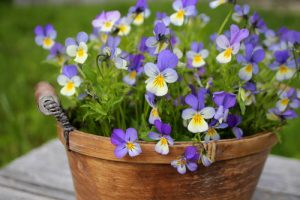
Pansies
Pansies are cheerful, bright, blooming flowers that are often among the first flowers to bloom after winter. They are guaranteed to bring colour to your garden where none existed before. They bring an fine and frilly texture to your garden that is perfect for cottage styles, as well as containers. Modern pansy varieties are more adaptable to heat though they still prefer a daytime temperature of 16°C.
Pansies prefer full to part sun locations and are happy in hanging baskets, combination containers, and as flower bed borders. You can start them from seed or purchase them as seedlings from nurseries like Aumanns. They are perfect to grow alongside spring and winter blooming bulbs like tulips, daffodils, and crocus. When planting pansies, make sure you work compost into the soil before planting. Pansies prefer well-draining soil and there is no need for fertiliser.
Other than that, pansy care is simple. Water them and remove dead flowers to extend the flowering period.
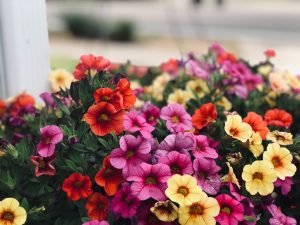
Petunias
Petunias offer amazing, long term colour in your spring and summer landscape and are perfect for brightening dreary borders with lovely pastel colours. And their care is simple, making them a great plant for beginners. They require regular watering and as much sunlight as possible. They will bloom more abundantly in full sun but will tolerate partial shade.
Prepare your soil with compost before planting and fertilise with a balanced, water-soluble fertiliser for blooming plants. Remove dead flowers for a long blooming season. Make sure you remove flowers at the base, to prevent the plant from going to seed. If petunias go to seed, they will slow and stop blooming.
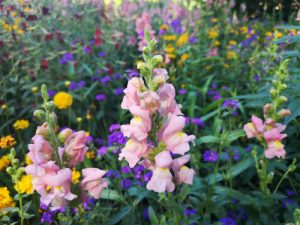
Snapdragons
Snapdragons are famous for their distinct, mouth like flower and stunning colours that are sure to light up any garden. They are an absolute must for any cottage garden and come in dwarf, intermediate, and tall flowering stems. They also add a fragrance to your garden that other blooming plants do not provide. This hardy plant can handle frost so plant them early in spring, in a full sun location, in well-draining soil.
Snapdragons require a few, well-placed clips to manipulate the plant into a bushy, filled out addition to your garden. Clip the top stem and any of the long side stems to encourage more flowers. Taller snapdragon varieties might require staking to remain upright. When the flowers begin to fade in the summer heat, clip the snapdragon plant back to 1/3 or ½ to allow for more flowers when the temperatures begin to cool in autumn. Remove dead flowers when you see them to encourage new flowers to grow.
When growing your snapdragons, it is important to keep them moist for the first few weeks. Once they have established, they require at least an inch of water a week if there’s been no rainfall. Water around the crown of the plant and let the soil dry out between waterings.
What to Plant in Spring: Fruit Trees
Fruiting trees are a wonderful addition to your garden. Not only are they gorgeous and provide shade during the hot summer months, they provide you with delicious fruit! Below are amazing fruiting plants you can add during spring.
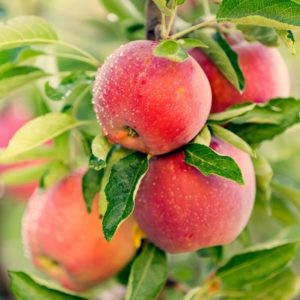
Apples
If you have the space, apple trees are one of the most rewarding trees you can grow. They are long living, hardy, provide shade, and produce delicious fruit for your family. Depending on the variety of apple tree you grow, some trees will produce fruit sooner than others as they mature.
Soil is incredibly important for apple trees. The pH of the soil has to be exact so it is important to have a proper soil test done. If the pH in the soil is wrong, the apple tree roots can burn. It is also important to plant your apple tree on the highest ground possible. Low lying frost can kill the blossoms on your tree that produce your apples so growing on higher ground protects the blossoms from an early death. This helps ensure a good crop of apples. Apple trees prefer full sunshine.
When planting your apple tree, you will need to dig a hole double the diameter of the root ball and at least two feet deep. Ensure the ground has thawed well before you try planting, and planting should be done sometime in mid-spring. Cover the root ball with soil and tamp it down firmly. This ensures the roots are completely touching dirt. You want to ensure there are no air pockets and the roots are getting all the nutrients they need from the soil.
Once the tree is established, you can feed it an apple tree specific fertiliser. Do not feed it during the planting stage as this will burn the roots. However, if you soil has the proper pH, you shouldn’t need to fertilise.

Lemons
Lemon trees are a classic backyard fruiting tree. This is because, as long as you provide their basic needs, they are easy to grow and are very rewarding. Lemon trees are the most cold sensitive of all the citrus trees so it is important to plant them where they will be sheltered from cold and frost. Growing them close to the house should remedy that.
Lemon trees need full sunlight for growth. When it comes to soil, they can tolerate a wide range of soil, including poorer varieties. However, like most plants, they do prefer well-draining soil. If the soil is slightly acidic, that is even better. When planting, lemon trees should be planted slightly higher than the ground. Dig a hole somewhat shallower than the root ball. Place the tree in the hole and replace the soil, tamping firmly.
Water your lemon tree and add some mulch to help retain moisture. Your lemon tree will want a deep watering once a week. If necessary, prune back to maintain the shape and height of the tree. You can also grow lemon trees as houseplants as they will be comfortable in a well-draining container that gives them plenty of room to grow. Keep the soil evenly moist and fertilise your lemon tree as needed.
Lemon trees prefer an average temperature of around 20°C and will go dormant in temperatures under 13°C. If you are growing your lemon tree inside, you might need to supplement your tree with fluorescent lighting as they need full sunlight to grow a healthy crop of lemons.
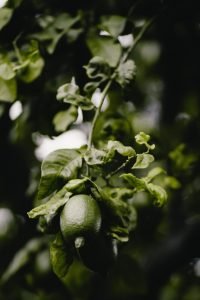
Limes
While not as common as lemons, limes have seen a recent surge of popularity. Just like lemons, they are rewarding and fun to grow. Most people will purchase a lime tree from a local garden supply centre, like Aumanns to transplant into their garden or into a container. Lime trees need plenty of sunshine and well-draining soil and/or containers. Lime trees must has good, well-draining soil. They will die if they are left in standing water. Make sure you choose a location that allows for good, southerly sunlight.
When planting in ground, you need to make sure the soil around the trees is higher than the ground around the planting hole. This prevents water pooling around the lime tree. When backfilling the hole or container, make sure you tamp the soil firmly around the root ball to prevent any air pockets forming around the roots.
After planting, caring for your lime tree is pretty straight forward. Water consistently as lime trees will drop their leaves if they are left dry too long. Fertilise frequently as they are heavy feeders and will deplete the soil around them quickly. They won’t survive in temperatures under 10°C so ensure they are protected from the cold.
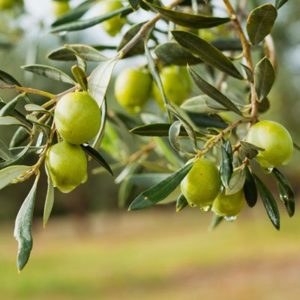
Olives
Olives are an essential part of any antipasto platter. And what better than to use your very own, homegrown olives? Growing olives is actually relatively simple given the proper location and their beautiful, silver leaves add a stunning touch to your garden. And their care is not demanding. They are best grown in areas prone to heat and plenty of sunshine. Once planted, olive trees are fairly low maintenance.
Most olive trees will take about three years to come to maturity and begin producing olives. To increase your olive crop, you can plant two olive trees close together. Olive trees need to be planted in well-drained soil in a sunny area. This is an evergreen that flourishes best in hot, dry areas, and will not do well in wet, winter soil. When planting, dig a hole about the size of the olive tree’s container. Place the root ball in the hole and fill with soil only. Do not add any soil medium, fertiliser, or compost. It is best to leave the olive tree to acclimatise to its new soil.
Provide drip irrigation for your olive tree, as it will need to be watered every day, especially during the summer months throughout the first year. Once your olive tree is showing new growth, provide the tree with a nitrogen rich compost, or a conventional fertiliser. Prune minimally during the first year and stake your olive tree to assist with stability.
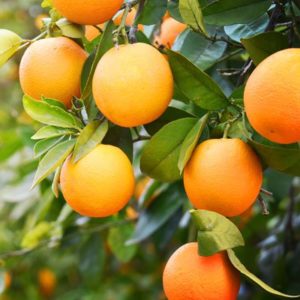
Oranges
Oranges trees are the perfect project for any home gardener, especially when your orange tree begins bearing fruit! Caring for an orange tree isn’t complicated and by following a few basic steps you can keep your tree healthy and producing fruit.
You can grow orange trees from seeds, however they tend to have a shorter lifespan and are susceptible to foot and root rot. They also won’t produce fruit until maturity, which can be up to 15 years! It is best to go to a nursery, like Aumanns, and purchase a grafted tree, similar to those used by commercial producers.
Orange trees require good watering, fertiliser, and pruning. Watering your orange tree will be based on the climate and the rainfall. They generally require regular watering in spring to prevent wilting. But remember, water lowers the solid content of the fruit. Generally, you will need to provide 1 – 1 ½ inches of water a week.
The kind of fertiliser you use on your orange tree will depend on what you want to use the fruit for. If you want more oil in the peel, you want a fertiliser with extra nitrogen. For lots of edible oranges, 0.5 – 1kg of nitrogen needs to be applied each year, per tree. You should also add potassium and phosphorus to your fertiliser along with a good range of micronutrients.
Orange trees don’t need to be pruned for shape. However, you should remove damaged or dying branches so the tree won’t be wasting energy.
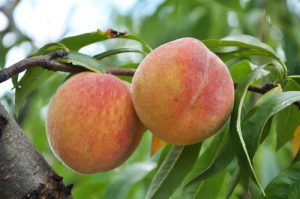
Peaches
Peaches are a favourite, juicy and delicious fruit. But they do require commitment if you want to grow them. They need a regular routine of feeding, pruning and management of pests and diseases. Peaches are self-fruitful, which means you don’t need to plant more than one. Choose a place for your tree that will get full sun and won’t be shaded by other trees or buildings. Peach trees can get up to 6m wide and 5m tall, so choose your site carefully. And choose a site that’s a little but elevated so the tree gets good air circulation.
Peach trees like soil that is well-drained and loamy. It needs to drain quickly during heavy rain as peach trees can’t survive being in waterlogged soil. You will also need to dig in a lot of compost and organic matter before planting your tree. A dormant, bare-rooted peach tree should be planted in late winter while a container grown tree should go into the ground in spring. Bare-rooted trees will need their roots soaked for 6-12 hours before planting. Dig your hole about 7.5cm deeper than the root ball and twice as wide. Fill the hole halfway up and then water well. When it drains, check to see if the tree is still positioned correctly then fill the rest of the hole with soil. Finish off with water again and mulch around the trunk.
Use about half a kilogram of 10-10-10 fertiliser for new trees and an additional half a kilogram each year until your tree is 10 feet tall. Prune your peach tree each year in spring to ensure the centre of the tree has free air flow and sunlight.
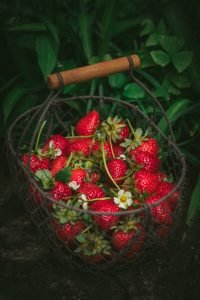
Strawberries
Strawberries are one of the most beloved fruits world wide. These versatile berries are ideal for a wide range of desserts, preserves, jams, and more. And, of course, they are perfect to eat just on their own. Easy to grow, they are ideal for beginners and as a project for children. They can be grown in hanging baskets, containers, and garden beds with ease – but they do need protection from opportunistic birds!
You can plant strawberries all year round, and they will typically fruit over spring and summer. They prefer sunnier conditions with a warm, northerly aspect in order to fruit. Strawberries need shelter from early frosts and hot summer winds, and may need shade from afternoon sun in hot summer climates.
Strawberries prefer well-draining soil that is moist but not wet. Dig in compost and mound beds to around 15cm to improve drainage. For best results, mulch with an organic material like straw, or lay down black plastic around the plants to prevent weeds. In pots, ensure you have a good quality potting mix with a slow release fertiliser and compost. Plant at least 30cm apart. To avoid rotting, don’t bury the runners too deep. Water weekly in summer with additional misting in extremely hot weather to keep the fruit cool. Don’t let the plants become dry, especially when fruiting. Watch out for aphids and red spider mites which can be controlled with commercial pest sprays. Prune back strawberry plants to about 2cm above the crown to ensure your plants produce another crop.
What to Plant in Spring: Vegetables
There is nothing better to use in your cooking than your own home grown vegetables. They bring a freshness and flavour to your cooking that store bought vegetables simply don’t have. There are a vast range of vegetables that you can grow in your own garden and spring is the perfect time to start planning. This will ensure that you will have a steady crop, ready for next winter.
No-dig vegetable garden beds are perfect for those who are time poor, who have pets that love to dig, or who simply cannot bend over enough to work a dig-in vegetable garden. Everyone deserves to have amazing, home grown produce! Here are the best vegetables to plant in spring.
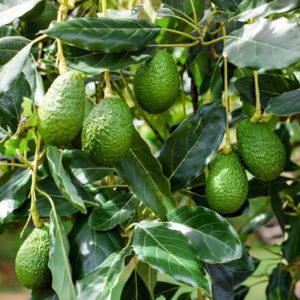
Avocado
We can’t deny that avocados are one of the most popular vegetables around. We use it in almost everything now, from smoothies to salads, to the infamous avocado on toast. So wouldn’t it be amazing to grow your own avocados, so you always have them on hand? Avocado trees prefer a tropical to sub-tropical temperature as the plant is very frost sensitive. However, they do grow well in pots, or in sheltered outdoor areas. Warm indoor temperatures combined with good care and sunlight can ensure you a crop of delicious avocadoes.
Choose a location for your avocado tree that has plenty of sun exposure and well-draining soil. Add plenty of organic matter to the soil and work sand into it if you find the soil isn’t draining well.
As fun as it is to grow an avocado pit in a glass of water, avocados won’t grow from the pit. Instead they are generally propagated from tip grafting and the seedlings from the graft are then planted. This is why we recommend you buy your tree already grown/growing from a nursery like Aumanns.
Avocado trees need deep, thorough watering in the growing season. They also need a decent fertiliser during winter. You don’t need to prune an avocado tree unless you want to remove dead branches. Most trees will begin producing avocados within a few years.
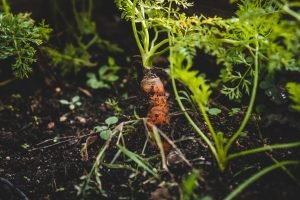
Carrots
Carrots are a classic home grown vegetable and a great one for kids to try. They are easy and fun to grow, making them perfect projects for kids of all ages. Carrots grow best in cool temperatures, like those in early spring. They grow well in small gardens and even flower beds, and can deal with being in a little shade.
If you want to grow carrot, you need to clear the soil surface of trash, rocks, and large pieces of bark. Start out with a sandy, well-draining loam soil to keep your carrots healthy. Heavy soils can cause carrots to mature slowly, and they can end up looking ugly and rough. Make sure you till the soil where the carrots are going to be planted as this softens and aerates the soil, making it easier for the carrots to grow.
Plant your carrots in rows about 30 cm apart and about 1cm deep. This means you will have enough carrots for everyone in the house to eat as 30cm of carrots gives you half a kilo of carrots. Make sure you weed around your carrots as weeds will take nutrients away from your carrots. Carrots will grow continuously as you plant them. After the first frost has passed, plant new seeds every two weeks for a continuous harvest until autumn. To check the size of your carrots, gently remove the soil from the top of the root and check the size. If you think they’re big enough for your needs, simply gently lift the carrot from the soil to harvest it.
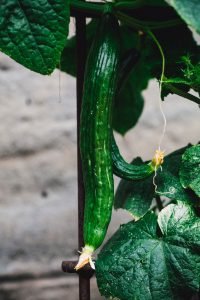
Cucumber
Cucumbers are a great, versatile vegetable to grow at home. They are perfect for salads, pickling or eating straight off the vine. They are also perfect for growing in small, limited spaces. You can start cucumbers by seed or saved and harvested from previous plants. They are best kept in peat pots and then transplanted into your garden once the danger of frost has passed. Cucumbers like warm, humid weather, plenty of sunlight, and loose, organic soil.
When planting, choose a site that has good drainage and fertile soil. The right soil will have plenty of organic matter in it, including compost. Remove any sticks, rocks, or other debris from the soil then mix in ample amounts of organic matter. Plant your cucumbers in rows about 2.5cm deep and ensure you begin training the vines up a fence or trellis as this will lift the cucumbers off the soil (and give your garden a neater appearance).
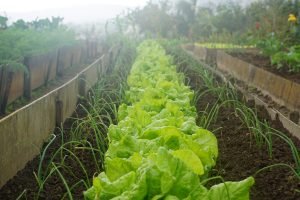
Lettuce
One of the easiest and least expensive ways to ensure you always have gourmet greens on the table is growing lettuce. It likes cool, moist weather in spring and can even be grown outdoors through winter. Once the ground has thawed, you can direct seed lettuce straight into the garden. You can try planting a variety of different species, as well as planting at different times, so you have lettuce maturing and harvestable throughout the growing season.
Lettuce prefers moist, cool conditions and can tolerate a light frost. It tastes better and the leaves are more tender then lettuce grows quickly. Before planting, till organic compost or high nitrogen fertiliser into the garden to encourage rapid leaf growth. Dues to its small seed size, it is better to scatter the seeds on top of the fine soil, then cover lightly with a thin layer of dirt. Mist lettuce with a fine spray to avoid disturbing newly planted seed. Plant in full sun for faster leaf growth, though it will thrive in some shade, too, making it ideal to plant between taller vegetable crops like tomatoes.
Harvest lettuce in the morning for crispier leaves. Wash them in cold water and dry with a paper towel. Place in a plastic bag and store in the fridge. Lettuce can be harvested once the outer leaves reach a usable size. You can either pull the plant up or cat the head of the plant off. If cutting, cut above the base to encourage regrowth.
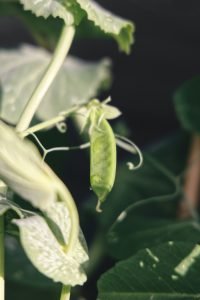
Peas
Like carrots, peas are easy and fun to grow, and can even be eaten straight off the vine. They make a fun project for kids to grow and harvest. Peas need full sun and well-draining soil to grow well. They also need far less fertilising than other vegetable so mixing in a little before planting will be plenty. For peas that grow on a vine, choose an area where they can grow up a trellis or another structure. Peas are also cool weather plants – so if you sow them too late in spring, they may struggle in the hotter months. Instead, they should be the earliest plants you start each year. As soon as the ground is workable, you can start sowing peas directly outdoors.
Plant them to a depth of about 2.5cm and only water if there’s not enough rain to provide 2.5cm of water a week. Apply mulch around growing peas to keep moisture in and minimise weed growth. To prevent disease to the plant, water at the base and keep an eye out for aphids.
Harvest peas at the right time because if they are left to over mature, they become inedible. Once the pods begin to flesh out with peas, check on them daily. Pick them as soon as the pods have reached their maximum size. If you think the pods are ready, pick one and eat it. It should be thin skinned, sweet, and tender. They store best if you cool them off quickly. Dunk them in cold water right after harvesting and then store in the fridge.
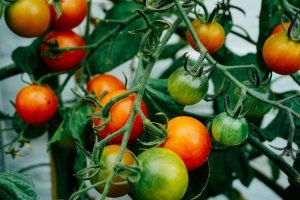
Tomatoes
There’s nothing compared to eating a perfect, vine-ripened tomato, straight from the garden. Tomatoes can grow in a variety of conditions, with the exception of extreme cold, and they don’t need a lot of space. And there are many varieties to choose from, depending on your preference. Cherry tomatoes are a big hit with children, can be grown in containers, and can even be eaten straight off the vine.
The soil should consist of organic matter, usually compost, with a significant amount of fertiliser and moisture. When growing tomatoes, you should start early since most take a while to mature. You can either grow from seed or from plants themselves – both are generally available from nurseries and garden centres like Aumanns. Seeds should normally take 6 to 8 weeks to grow.
Tomatoes don’t thrive in cold temperatures and prefer an average temperatures over 18°C. Ensure the threat of frost is over before planting seeds or plants in your garden. They require full sun and should have proper protection from strong winds. Staking tomatoes makes harvesting easier as they tomatoes will be easier to harvest off the ground.
Tomatoes require a lot of water so to help retain moisture, you should always mulch tomato plants and grow them in an area accessible to water. Check your plants daily for ripe tomatoes, as picking them will encourage more production.
What to Plant in Spring: Herbs
Just like fresh, homegrown vegetables, sing your own herbs, freshly picked from the garden, are far superior to store-bought, dried, or paste herbs. Herbs can be grown in garden beds as well as pots, meaning even those living in small apartments can enjoy fresh, seasonal herbs. Here are the best herbs to plant in Spring.
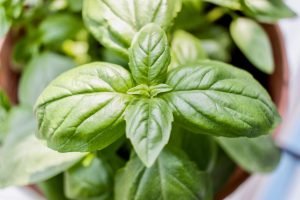
Basil
Basil is one of the most popular herbs to grow at home. Growing basil indoors, outdoors, and in a container is easy to do. Choose a location or container with excellent drainage and good sunlight. You can also choose to grow basil from the plant or from seeds. If growing from seeds, scatter them over the soil and cover lightly with soil and water thoroughly. if growing from plants, dig a small hole, tease out the root ball a little, and plant the basil before watering thoroughly.
Basil is very sensitive to cold and even a light frost can kill basil. Do not plant seeds or plants until the risk of frost is over. The trick to growing basil large and abundant is to harvest it often – the more you harvest, the more basil will grow. Ensure you remove flowers or the leaves will lose their taste.
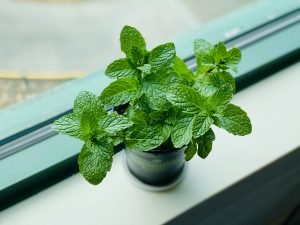
Mint
Mint has always been popular, few people know how aggressive a plant it is in the garden it is. If kept under control, it is a rewarding plant to grow and a fantastic herb to have on hand. While mint is mostly used as a flavouring or a garnish, other types of mint can be grown for their unique aromas.
All mint varieties, except peppermint, can be grown from seed. One of the best ways to grow mint without it spreading like crazy, is to grow it in containers, sink the plant in soil and leave the top sticking an inch or so above. Space the containers at least a foot apart to prevent cross pollination.
Mint grows best in a wide variety of settings but grow best in organically rich, moist but well-drained soil. Full sun to partial shade is also best for growing mint. You can harvest mint when the plant begins to flower.
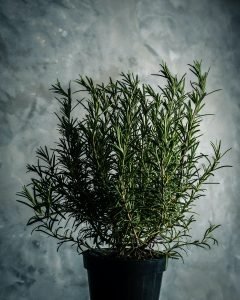
Rosemary
Rosemary is a beautiful, delicious herb, an attractive plant for your garden, and gives off a fantastic aroma. While it is normally used as a herb, they are also a stunning ornamental plant for inside and outside use. Rosemary plant care is remarkably easy. They need well-drained, sandy soil, and at least 6-8 hours of sunlight each day. Rosemary thrives in warm, humid environments and hates extremely cold temperatures. They also prefer to be somewhat on the dry side, so thoroughly water your plant when the soil is dry to the touch but allow the plants to dry out between waterings. Even indoor grown rosemary will require lots of light so place the plant in a suitable location, free of drafts.
Pruning rosemary will ensure a bushier plant. Snip sprigs just like you would trim back a house plant. Trim rosemary once blooming has stopped but do not take more than a third of the plant at any time. Make sure you make cuts just above the leaf joint. These sprigs can be dried like any other herb, by hanging in a bundle in a cool, dry place.
You can grow rosemary from cuttings. Cut stems about 5cm long and remove leaves from the bottom two-thirds of the cutting. Place the cuttings in some perlite and peat moss, spraying with water until the roots begin to grow. Once the roots of the cuttings developed, you can plant them like any rosemary plant. You should also repot your rosemary once a year to prevent it becoming root bound.
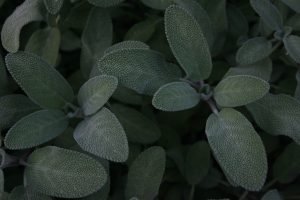
Sage
Planting sage is incredibly easy. Sage should be planted in full sun, in well-draining soil, as sage does not like its roots to remain wet. It grows best in a hot, dry climate. Planting sage from seeds requires patience because they are slow to germinate. Scatter the seeds over the coil and cover them in a layer of soil. Keep the soil damp but not soaked. Not all the seeds will germinate but the ones that do may take up to 6 weeks to grow. This is why sage is generally grown from softwood cuttings off a mature sage plant.
Sage is a perennial herb that will grace your garden for years, is easy to grow, and makes a wonderful addition to every meal. It makes for a fantastic line up of indoor herbs along with basil, rosemary, mint, and thyme.
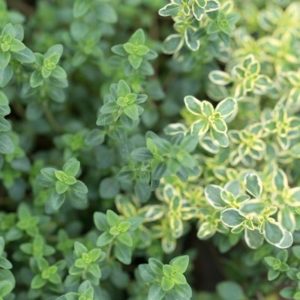
Thyme
Thyme has been long used in cooking. It is a versatile plant, making for tasty dishes and a pretty addition to your indoor and outdoor gardens. They are also easy to grow, and will flourish with little care. They can be grown from seed but most people prefer to grow from plants bought from nurseries like Aumanns – like they would with other herbs.
Interestingly, the flavour of thyme actually comes from active neglect of the plant. Growing thyme in poor soil, with little water, will actually cause the thyme to grow better. For this reason, thyme is excellent for beginners and areas with little water.
Harvesting is easy. Simply snip off what you need for your recipe. Once the plant is established, it is very hard to over-harvest the plant. But if the thyme is just planted, be sure not to cut back more than one third.
Come down to one of our Aumann’s Garden Supplies stores today to find the perfect spring plants for your garden. Or chat to our team members to find out more about your spring planting options!

